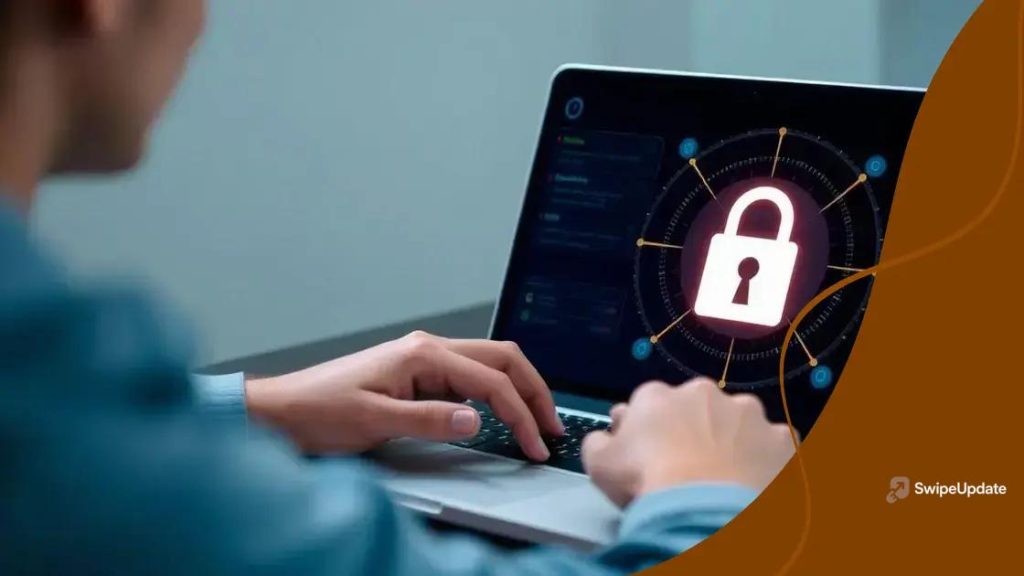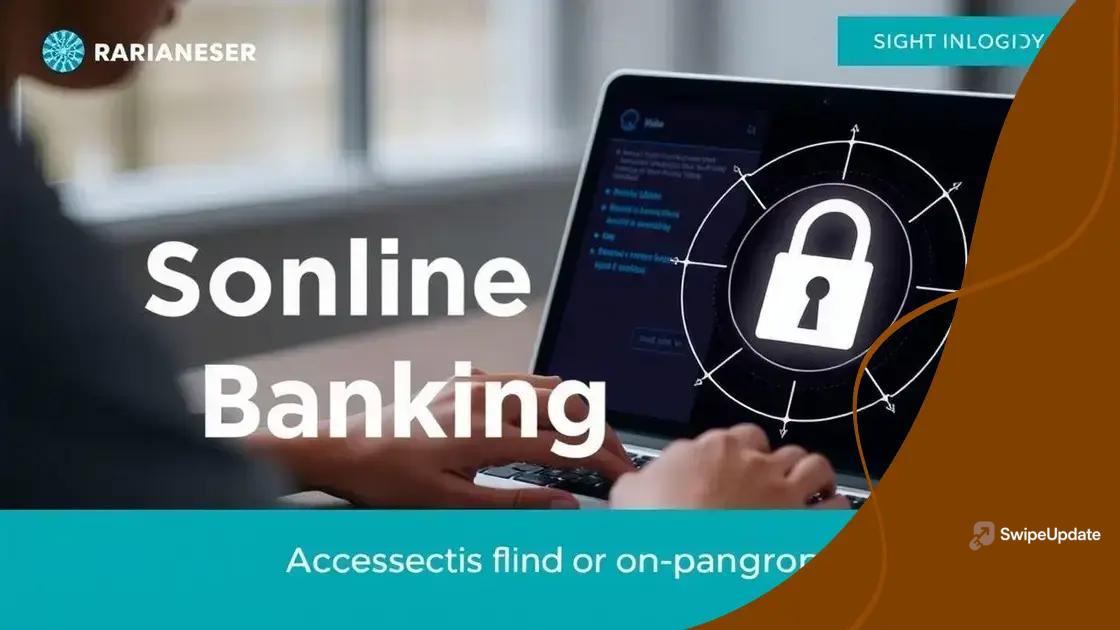Digital banking security concerns: what you need to know

Digital banking security concerns involve threats like phishing, malware, and account takeovers, necessitating strong passwords, two-factor authentication, and ongoing monitoring to protect personal financial information.
Digital banking security concerns are more relevant than ever as we rely on online services for our financial needs. But what are the main issues? Let’s dive into how you can protect yourself.
Understanding digital banking security risks
Understanding digital banking security risks is essential for anyone using online financial services. With the rise of technology, these risks have increased, making it critical to be aware of potential threats.
Common Types of Risks
There are several common risks associated with digital banking that users should be aware of. By knowing these threats, you can take steps to protect your information and finances.
- Phishing attacks: Fraudsters often send fake emails to steal your personal information.
- Data breaches: Hacking incidents can expose sensitive information.
- Malware: Some malicious software is designed to capture your login details.
- Account takeover: Unauthorized users may gain access to your bank account.
Another significant concern is identity theft. When your personal information is compromised, thieves can open accounts in your name or make unauthorized purchases. To combat this, it’s vital to monitor your accounts regularly.
Why Awareness Matters
Being aware of these risks empowers you to take proactive measures. Following best practices can significantly reduce your chances of becoming a victim. Regularly updating your passwords, using two-factor authentication, and keeping your devices secure are all effective strategies.
Furthermore, educating yourself about the latest scams is crucial. Cybercriminals are constantly evolving their methods, so staying informed helps you recognize when something is off.
In summary, understanding digital banking security risks and adopting protective measures can lead to a safer online banking experience.
Common threats to online banking
Common threats to online banking can jeopardize your financial security if you are not vigilant. Understanding these threats is essential to safeguarding your personal information.
Types of Threats
Online banking users face a variety of threats. Familiarizing yourself with these can help you recognize red flags and take action before it’s too late.
- Phishing: This method involves fraudulent emails or messages that appear to be from legitimate banks, aiming to extract sensitive details.
- Malware: Malicious software can infiltrate your devices to steal your login information or track your online activity.
- Account Takeover: Cybercriminals may gain unauthorized access to your bank account, allowing them to make unauthorized transactions.
- Wi-Fi Eavesdropping: Using public Wi-Fi can expose your credentials if the network is not secure.
It is crucial to stay aware of these threats, particularly as technology evolves. Fraudsters are developing new tactics all the time, making it essential for users to remain informed and vigilant.
How to Identify Fraud
Detecting fraudulent activity early can prevent a lot of stress. Always look for strange transactions on your bank statement and report any discrepancies immediately. If you receive unexpected communication claiming to be from your bank, verify its authenticity before responding.
In addition, be careful when providing personal information online. Always ensure that websites are secure by checking for HTTPS in the URL before entering your login credentials. This small step can significantly reduce the risk of data theft.
Ultimately, being proactive about recognizing common threats to online banking can lead to safer financial practices.
Best practices for secure transactions

Implementing the best practices for secure transactions is vital for anyone engaging in online banking. By following these guidelines, you can significantly reduce your risk of fraud.
Strong Passwords
One of the simplest ways to protect your accounts is by using strong passwords. Make sure your passwords are at least 12 characters long and include a mix of letters, numbers, and symbols. Avoid using easily guessable information like birthdays or names.
- Change your passwords regularly.
- Do not share your passwords with anyone.
- Use a password manager to keep track of your passwords.
Additionally, enable two-factor authentication (2FA) wherever possible. This adds another layer of security by requiring a second form of verification, such as a code sent to your phone.
Secure Connections
Always ensure you are using a secure internet connection when banking online. Avoid public Wi-Fi networks, as they can be vulnerable. When accessing your bank’s website, ensure the URL begins with “https://” which indicates a secure connection.
Moreover, keep your devices updated with the latest software and security patches. This helps protect against vulnerabilities that cybercriminals might exploit.
Lastly, regularly monitor your accounts for any suspicious activity. If you notice anything unusual, report it immediately. By staying vigilant, you can better protect your finances.
The role of technology in combating fraud
The role of technology in combating fraud is vital as online banking continues to grow. Innovation in security measures helps protect consumers from potential threats.
Advanced Encryption
One key aspect of technology is advanced encryption. This process converts sensitive information into a secure format, ensuring that data remains confidential during transmission. For example, when you enter your login details, they are encrypted, making it difficult for hackers to intercept.
- Encryption standards: Look for banks using industry-standard encryption protocols.
- Data protection: Encryption protects user information both at rest and in transit.
- User trust: Understanding encryption increases trust in digital banking.
Moreover, machine learning plays a significant role in identifying fraudulent activity. Algorithms can analyze transaction patterns and detect unusual behavior, alerting users and banks to potential fraud in real time.
Two-Factor Authentication
Two-factor authentication (2FA) adds an extra layer of protection. When logging in, users not only enter their password but also a code sent to their phone or email. This makes it harder for unauthorized users to gain access, even if they know the password.
Additionally, new biometric technologies, like fingerprint scanning and facial recognition, enhance security. These technologies verify user identity through unique physical traits, making it even more challenging for criminals to succeed.
In conclusion, technology plays an essential role in combating fraud. By utilizing advanced encryption, machine learning, and multi-factor authentication, banks can better protect customers and their sensitive information.
Future trends in digital banking security
Future trends in digital banking security are crucial as technology evolves and cyber threats increase. Staying informed about these trends can help users protect their financial information and enhance their security practices.
Increased Use of AI
Artificial intelligence (AI) is expected to play a significant role in securing online banking. AI can analyze vast amounts of data to detect fraud patterns much quicker than humans. It can identify suspicious transactions in real time and alert users and banks instantly.
- Fraud detection: AI algorithms continuously learn from transaction data, improving their ability to spot anomalies.
- Risk assessment: AI can evaluate the risk level of transactions based on user behavior and historical data.
- 24/7 monitoring: AI systems can provide constant surveillance of accounts for any unusual activities, offering enhanced protection.
Moreover, customers can expect stronger identity verification methods. Biometric authentication will likely replace traditional passwords. This includes fingerprint scanning, facial recognition, and even voice recognition technologies. These methods are not only convenient but also provide a higher level of security.
Blockchain Technology
Blockchain technology may also change the face of digital banking security. By enabling secure and transparent transactions, blockchain can reduce fraud and enhance trust. This system stores transaction data across a network of computers, making unauthorized access difficult.
Additionally, financial institutions are likely to prioritize user education. With evolving security measures, it’s essential that customers understand how to protect themselves. Banks may offer resources and training to ensure users are aware of the best practices for safe online banking.
Looking ahead, embracing these future trends in digital banking security can foster a safer environment for all users in the digital banking space.
FAQ – Common Questions About Digital Banking Security
What are common threats to online banking?
Common threats include phishing attacks, malware, and account takeover attempts, all of which can compromise your personal information.
How can I protect my online banking accounts?
You can protect your accounts by using strong passwords, enabling two-factor authentication, and regularly monitoring your transactions.
What role does technology play in securing digital banking?
Technology plays a crucial role by using advanced encryption, AI for fraud detection, and biometric authentication methods to enhance security.
Are there any emerging trends in digital banking security?
Yes, trends include increased use of AI for security, the adoption of biometric authentication, and the implementation of blockchain technology to secure transactions.
